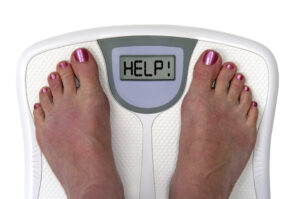The information provided here is for educational purposes. Address individual medical or psychological concerns with your healthcare provider.
Contrary to common belief, having overweight or obesity does not mean you have an eating disorder nor any other psychological disorder. However, if your weight is greater than what is healthy for your height, you may be at risk for medical complications and emotional challenges.
On this page we define weight status, explain the determinants of weight, and introduce you to the basics of weight management.

Obesity Definitions
Weight status is defined as a ratio of weight to height called Body Mass Index, BMI for short. Enter your weight in pounds and height in inches to determine your BMI.
Use the Weight Category table below to determine where your BMI falls. As your weight moves from Healthy to either Underweight or Overweight and Obese, the risk of illness increases.
| Weight Category | BMI |
|---|---|
| Underweight | Under 18.5 |
| Healthy | 18.5 to 24.9 |
| Overweight | 25 to 29.9 |
| Obese | 30 and above |
The healthy range for your height is pretty broad. For example, someone who is 5 feet 4 inches tall could weigh anywhere from 108 to 145 pounds before slipping out of the Healthy category. That is a 37-pound range. Plenty of room to be yourself!
Weight Determinants
Three forces come together to determine body size: biology, environment, and psychology.

Biology. We are built to thrive in an environment where food is neither easy to come by, nor calorically dense. When food is plentiful, our bodies store energy for times of scarcity and while seeking food, we ignore hunger to remain focused on the hunt. We are wired not to be especially bothered by increasing satiety if good food is available. (Think about it, if food is hard to come by, it makes good sense to eat as much as you can when it is available!) As recently as 100 years ago this design worked well for us. We worked hard, ate heartily, and few people became obese.
Environment. Modern life requires little in the way of physical activity. For most of us, hunting and gathering has been replaced by driving and ordering. In addition, much of our food is manufactured in such a way that every bite contains more calories than it did 100 years ago. Thus, our ability to store energy and eat heartily now means we take in a great number of calories and efficiently store them for a food-deficient future that rarely arrives. Requiring few calories to earn our way and having almost eliminated the intermittent famines that thinned our energy stores, we become heavier and heavier.
 Psychology. Entwined with biology and environment is that powerful force that makes us human—psychology. Our minds attach meanings to food and eating that make them not only essential to our physical survival, but also to our social and emotional well-being.
Psychology. Entwined with biology and environment is that powerful force that makes us human—psychology. Our minds attach meanings to food and eating that make them not only essential to our physical survival, but also to our social and emotional well-being.
Looked at this way, it is easy to understand why weight can be difficult to manage. Juggling the forces that shape our food intake while trying to squeeze into smaller frames than our genetics dictate, is a recipe for deprivation, frustration, and weight rebound. Hence, careful assessment of a reasonable and healthy target weight range is the essential first step in weight management. That is the key to working with your biology—and much easier than fighting your biology.
Foundation of Weight Management
Most of the products and programs on which we spend millions fail because they do not lay a solid foundation on which to build the changes they promote. They tell you what to eat, how to exercise, or offer drugs that mess with your biology—but they skip the groundwork that helps you implement their strategies. Here is that critical groundwork:
- Target a sensible range. If you come from a family with many overweight or obese people, it is unlikely that you will ever look like the skinny “after” models in commercials. If you set targets that are reasonable for you, you dramatically increase the likelihood of achieving your goals.
- Start moving where you are. If you have been sedentary until now, stand up and walk around your sofa. Then keep walking. Slowly increase your activity as your fitness improves. Leave intense workouts for down the road when you are ready for them. Jumping in sooner will make you quit.
- Eat mindfully. This means eating only at a Designated Eating Place (the table at home, lunchroom at work/school) and pay attention while you eat (no TV or computer, put away the books and puzzles). When there is food in your mouth, keep your hands empty. This will slow you down and require a conscious decision before the next bite. As mindful eating becomes a habit, it becomes easier to modify what, how much, and when you eat.
Most overweight people find that just laying this foundation results in some weight loss. Depending upon how overweight you are, these changes alone may be sufficient. If not, you may consider self-help books (see Sensible Books), programs, diets, or other more extreme strategies. However, always remember that without this solid foundation, future efforts will be no more successful than those you have already quit. Start building that foundation!
More about Obesity & Overweight
Can be found at: National Heart, Lung, and Blood Institute
